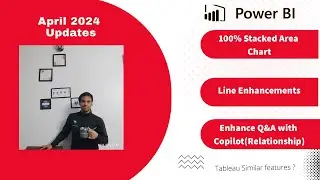Set Incremental Refresh with Power BI Part 2- PL 300 Questions
🗣 CONNECT WITH ME ON SOCIAL
💥My Website💥
►https://dancesingwithdata.com
💥Check the first part here 💥
► • Incremental Refresh with Power BI (PL...
💥Twitter 💥
► / riteshbisht01
💥Linkedin💥
► / ritesh-bisht-22238913
💥Power BI Community 💥
►https://community.tableau.com/people/...
💥My Tableau Channel💥
► / riteshtableauinfocom
💥 Pick the correct PL 300 Questions options💥
A. When you have defined the incremental refresh policy in Power BI Desktop, to apply that refresh policy, you need to publish the report to Power BI service.
B. Table data is filtered by using Power Query date/time parameters with the reserved, case-sensitive names RangeStart and RangeEnd.
C. Table data is filtered by using Power Query date/time parameters with the reserved, case-sensitive names StartRange and EndRange
D.DirectQuery partition is only supported for datasets in Premium capacities
💥Answer💥 : A,B, D
2. True or False
Most data sources that support SQL queries support query folding. Data sources like flat files, blobs, and some web feeds often do not.
💥Ans💥: TRUE
3. The Detect data changes setting enables even more selective refresh. You can select a date/time column used to identify and refresh only those days where the data has changed. This assumes such a column exists in the data source, which is typically for auditing purposes.
A.This should not be the same column used to partition the data with the RangeStart and RangeEnd parameters
B. This should be the same column used to partition the data with the RangeStart and RangeEnd parameters
C. It can be either A or B
D. This should come only from the Calendar table
💥Ans💥 A
https://learn.microsoft.com/en-gb/pow...
https://learn.microsoft.com/en-us/pow...
Incremental refresh extends scheduled refresh operations by providing automated partition creation and management for dataset tables that frequently load new and updated data. For most datasets, this is one or more tables that contain transaction data that changes often and can grow exponentially, like a fact table in a relational or star database schema. An incremental refresh policy to partition the table, refreshing only the most recent import partition(s), and optionally leveraging an additional DirectQuery partition for real-time data can significantly reduce the amount of data that has to be refreshed while at the same time ensuring that even the latest changes at the data source are included in the query results.
With incremental refresh and real-time data:
Fewer refresh cycles for fast-changing data – DirectQuery mode gets the latest data updates as queries are processed without requiring a high refresh cadence.
Refreshes are faster - Only the most recent data that has changed needs to be refreshed.
Refreshes are more reliable - Long-running connections to volatile data sources aren't necessary. Queries to source data run faster, reducing potential for network problems to interfere.
Resource consumption is reduced - Less data to refresh reduces overall consumption of memory and other resources in both Power BI and data source systems.
Enables large datasets - Datasets with potentially billions of rows can grow without the need to fully refresh the entire dataset with each refresh operation.
Easy setup - Incremental refresh policies are defined in Power BI Desktop with just a few tasks. When published, the service automatically applies those policies with each refresh.
When you publish a Power BI Desktop model to the service, each table in the new dataset has a single partition. That single partition contains all rows for that table. If the table is large, say with tens of millions of rows or even more, a refresh for that table can take a long time and consume an excessive amount of resources.
🗣 CONNECT WITH ME ON SOCIAL
💥Check the first part here 💥
► • Incremental Refresh with Power BI (PL...
💥Twitter 💥
► / riteshbisht01
💥Linkedin💥
► / ritesh-bisht-22238913
💥Power BI Community 💥
►https://community.tableau.com/people/...
💥My Tableau Channel💥
► / riteshtableauinfocom



















